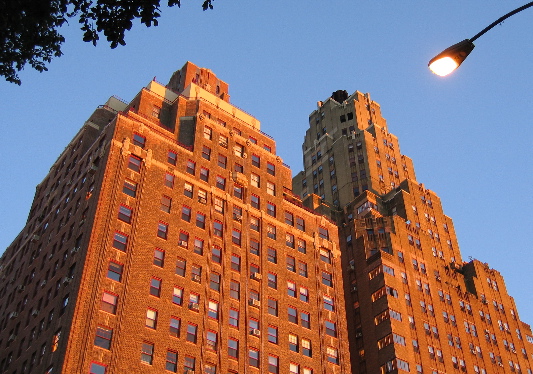Sunday, December 19, 2004
A building's history in the New York Times

Riverside Drive: 1931-1957
A sad and sordid history for the most part. But that's what sells newspapers.
Nov 13, 1931- “Two Women and a 4-year-old girl were injured yesterday afternoon when the automobile in which they were riding was in collision with the rear end of a Fifth Avenue bus on Riverside Drive and Ninety-sixth Street. The accident occurred when the bus stopped suddenly to pick up a passenger and the private car, driven by Joseph Troy, 44, a chauffeur, of 124 West 109th Street, which had been closely following the larger vehicle, did not stop in time. The automobile was owned by Alexander Ostagard of 315 Riverside Drive, whose sister, Olga, 35, was among those injured.”1
What I want to know is what the 5th avenue bus was doing on Riverside Drive. Perhaps it went to 5th Ave.
Dec 19, 1931 - “Swindlers obtained $400,000 from Katherine Beeson, sister of Charles E. Beeson, vice president of the Pittsburgh Steel Company, it was charged yesterday afternoon, when Peter Visconti, 39 years old, of 315 Riverside Drive, was arrested on a grand larceny complaint made by Miss Beeson.” Visconti, a.k.a. Peter Visco, was a stock salesman, manufacturer, and former pugilist.2
Nov 18, 1935 - “The admiration of Miss Olga Ostergard of 315 Riverside Drive for Will Rogers is expressed in her own memorial to the cowboy humorist in the form of a life of Rogers as told in newspaper and magazine stories.
Miss Ostergard has been keeping her scrapbook on Rogers since she first saw him on the stage in 1929 when he substituted for Fred Stone.”3
A different spelling but surely the same Olga who was involved in the car crash.
Aug 23rd, 1936 - “An unidentified man, about 25 years old, fell or jumped to his death about 6 o’clock yesterday evening fromthe roof of a twenty-story apartment house at 315 Riverside Drive, according to the police. he wore a blue polo shirt, black sneakers and gray shorts. Persons on the Drive told police that earlier they had seen him running along a pathway there. The body landed on the Drive after striking an extension on the seventeenth story. The man was 5 feet 8 inches tall, had black hair and blue eyes.4
Dec 5th, 1938 - “Mrs. Helen F. Ryan, 38 years old, who, as Helen Cressman, appeared in the Ziegfeld Follies in 1922, was discovered a suicide yesterday in her apartment at 315 Riverside Drive. She was found by the superintendent at 6 A.M., seated in the kitchen near a gas stove with a jet open.”5
Her 12 year old daughter, affected by the gas, was treated, and placed with relatives.
Aug 4th, 1947 - “For the first time in its history the Police Department this morning will mobilize its entire personnel of nearly 18,000 men to sweep from street, saloon, pool hall and other hangouts the horde of bookmakers, estimated to run into the thousands, that infests the city.”6 Arrested before the sweep police arrested a “big-time gambler and bookmaker” namedVincent Alo (aged 43), of 315 Riverside Drive.
Nov 10, 1956 - 315 RSD sold by Laura Hall and others to Madison Properties. The building was valued at $760,0007
Jun 15, 1957 - “The police Department began a concerted drive yesterday to rid the city of “narcotics peddler, gamblers, prostitures, procurers, tinhorns, and drifters.”” Of the 100 arrested at the time fo the article, nine were ‘bigshots.’ One of those nine was Vincent (Jimmy Blue Eyes) Alo (aged 53) of 315 Riverside Drive, described as an associate of Frank Costello.8
Again they're rounding up the usual suspects, and Jimmy Blue Eyes is amongst them.
Links
Jimmy “Blue Eyes” Alo - "According to my best
recollection,I don't remember."
1 New York Times Nov 13, 1931 “2 Women and Child Hurt in Crash on Drive.”
2 New York Times Dec 19, 1931 “Woman Charges $400,000 Swindle.”
3 New York Times Nov 18, 1935 “Roger Admirer Keeps Scrapbook on His Life.”
4 New York Times Aug 23, 1936 “Dies in Plunge on Drive.”
5 New York Times Dec 5, 1938 “Ex-Follies Girl Suicide.”
6 New York Times Aug 4, 1947 “18,000 City Police Begin Drive Today to Rout ‘Bookies.’”
7 New York Times Nov 10, 1956 “Apartments sold on the West Side.”
8 New York Times Jun 15, 1957 “Police Open Drive on Undesireables.”
Friday, December 03, 2004
water towers
Memory is redundant: it repeats signs so that the city can begin to exist.
Invisible Cities - Italo Calvino
Watertowers stand sentry above New York like a silent army. You sometimes become aware of their existance only when you see their shadows against a building's wall (a sight which must be more common in winter than in summer given the angle of the sun). Anyway-they're a benign presence. Helpfully providing water pressure to put out fires, or allow you to shower on the 13th floor. Despite their uniformity, they represent a pre-industrial technology, put together by hand and (to an extent) custom built. Pigeons are their only enemy. Hawks perch on them scanning the sidewalk for squirrels and other small critters.







